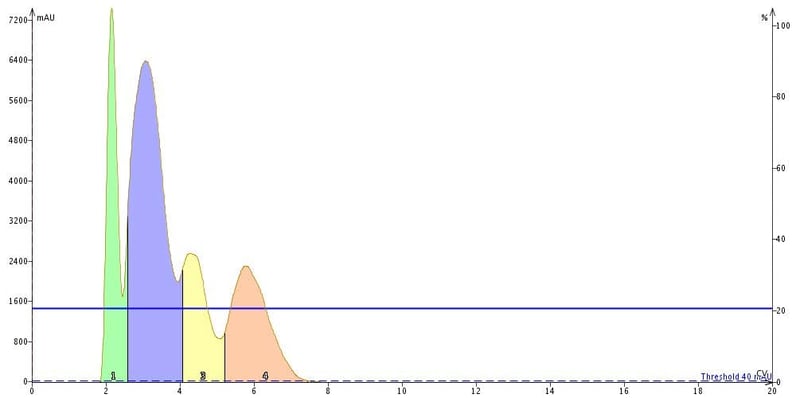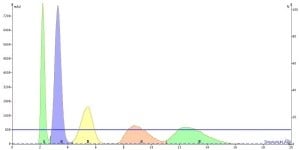In all my years of working with medicinal and organic chemists, I have found that choosing how many grams of silica to use for purification by flash chromatography is something frequently guessed at. Getting the size of the column right is awfully important because using too few grams of silica will doom your purification to failure and using more an optimal mass of the stationary phase means the purification consumes excess silica, solvents, and a chemist's time.
To determine the optimal amount of silica for a purification, I rely on a factor called ΔCV (delta Column Volume) to identify the best loading capacity on any cartridge. I have also found that ΔCV this is a better loading capacity predictor for flash purification than ΔRf.
Column Volume (CV) is a term commonly used with flash chromatography to describe compound retention or the amount of volume of mobile phase required to elute a compound. A specific compound's CV is equal to the reciprocal of its Rf (1/Rf).I have previously discussed how solvent selection and solvent ratios impact purification quality and loading capacity. In this post I will discuss why ΔCV is a better separation quality predictor, and therefore load capacity estimator, than ΔRf.
To determine cartridge size and load amount many chemists use a term called ΔRf (the difference between two adjacent compounds Rf values). There is a downside to using ΔRf as it does not fully take into account the compounds' resolution. For example, a pair of adjacent compounds with Rf values of 0.35 and 0.40 (ΔRf = 0.05) will not provide the same load or separation quality (resolution)as for the same compounds with Rf values of 0.15 and 0.20 (same ΔRf) even though all Rf values are in the optimal Rf zone (0.1-0.4). This is because the amount of actual resolution between the higher Rf values is actually less than with the lower Rf values. This is best exemplified when you convert Rf values to column volumes (CV) using the formula CV = 1/Rf. Using CV and ΔCV, compound resolution is factored in and separation quality and loading is more predictable.
The use of CV simplifies the transfer of TLC data to column chromatography because it is independent of flow rate and column size. To determine separation quality and estimate loading capacity for a chemical mixture it is advantageous to use ΔCV over ΔRf; a good example follows.
The Rf data below shows an increasing ΔRf for compounds 3 and 4 with increasing EtOAc content. This data also shows the ΔRf for compound 3 and compound 2 decreases with increasing EtOAc content until 40% EtOAc when it increases significantly. If you think about this you will find the ΔRf data are not rational - our first indication that ΔRf is not appropriate for determining separation quality. So, if you were to rely on these ΔRf values to determine the separation conditions and loading capacity, the data actually predict a higher sample load and better separation in 40% EtOAc than 30% EtOAc, again not rational given the Rf values at these EtOAc concentrations.
| Rf | 10% | 20% | 30% | 40% | ΔRf | 10% | 20% | 30% | 40% |
| 1 | 0.83 | 0.84 | 0.86 | 0.89 | 1-2 | 0.44 | 0.36 | 0.25 | 0.00 |
| 2 | 0.38 | 0.48 | 0.61 | 0.89 | 2-3 | 0.23 | 0.16 | 0.10 | 0.17 |
| 3 | 0.15 | 0.32 | 0.51 | 0.72 | 3-4 | 0.10 | 0.10 | 0.12 | 0.13 |
| 4 | 0.06 | 0.22 | 0.39 | 0.59 | 4-5 | 0.02 | 0.06 | 0.10 | 0.11 |
| 5 | 0.04 | 0.16 | 0.29 | 0.48 |
However, when we look at CV and ΔCV for the same compounds a different picture emerges where ΔCV decreases with increasing EtOAc concentration. This does make sense since we know retention decreases and therefore the resolution also decreases with increasing EtOAc content (see chromatograms below). Therefore, ΔCV becomes the limiting factor in determining separation quality and, therefore, loading capacity.
Using data for the same pairs of compounds we see that at 20% EtOAc there is a ΔCV of 1.04 between compounds 2 and 3 and a slightly better ΔCV of 1.42 between compounds 3 and 4. Though not horrible, it is not ideal if we want to maximize our load on the smallest possible flash chromatography cartridge. However, at 10% EtOAc the ΔCV for both sets of compounds (2 and 3, 3 and 4) are considerably better with the ΔCV for compounds 2 and 3 being 3.90 and for compounds 3 and 4 being almost 11! Based on this ΔCV data purification at 10% EtOAc provides a far superior separation on the same size flash column.
| CV | 10% | 20% | 30% | 40% | CV | 10% | 20% | 30% | 40% |
| 1 | 1.21 | 1.19 | 1.16 | 1.12 | 1-2 | 1.39 | 0.89 | 0.49 | 0.00 |
| 2 | 2.60 | 2.08 | 1.65 | 1.12 | 2-3 | 3.90 | 1.04 | 0.32 | 0.27 |
| 3 | 6.50 | 3.13 | 1.96 | 1.39 | 3-4 | 10.83 | 1.42 | 0.59 | 0.31 |
| 4 | 17.33 | 4.55 | 2.55 | 1.70 | 4-5 | 7.67 | 1.70 | 0.85 | 0.39 |
| 5 | 25.00 | 6.25 | 3.40 | 2.09 |

So, when determining which cartridge size to use for any purification ensure that you have maximized ΔCV for your compound of interest from its nearest neighbors.
What has been your experience? Let me know.
If you're wanting to learn more about Flash Column Chromatography, check out the white paper "Successful Flash Chromatography"!

 Organic Workflow
Organic Workflow Peptide Workflow
Peptide Workflow Scale-Up Flash Purification
Scale-Up Flash Purification  Sample Preparation
Sample Preparation Biomolecule Purification
Biomolecule Purification Oligo synthesis
Oligo synthesis Scavengers and Reagents
Scavengers and Reagents Service & Support
Service & Support Accessories & Spare parts
Accessories & Spare parts Investors
Investors Reports & News
Reports & News The Share
The Share Corporate Governance
Corporate Governance Calendar
Calendar Sustainability
Sustainability Our Offering
Our Offering Our History
Our History Our Locations
Our Locations Leadership
Leadership
